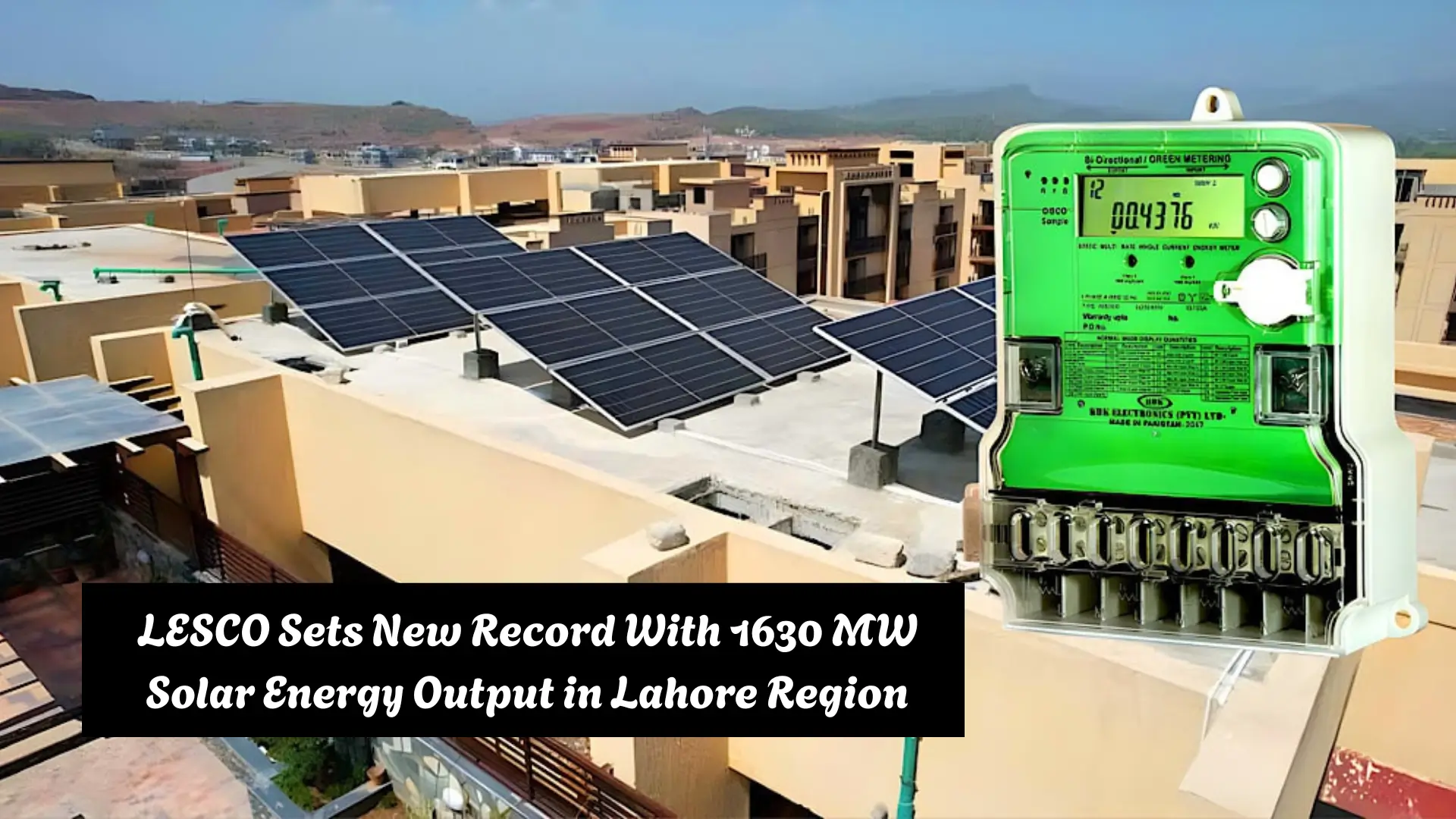LESCO Sets New Record With 1630 MW Solar Energy Output in Lahore Region. The Lahore Electric Supply Company (LESCO) has reached a historic milestone by generating 1,630 MW of solar energy, marking a major shift toward clean and affordable power in the region. With thousands of consumers contributing electricity through solar net metering, Lahore is quickly becoming a leading solar-powered region in Pakistan. This article explains LESCO’s record performance, consumer benefits, production data, and what this achievement means for Pakistan’s energy future.
Solar Power Generation in LESCO Hits a Record 1,630 MW
LESCO’s operational areas—including Lahore, Kasur, Sheikhupura, Okara, and Nankana Sahib—have reported the highest-ever solar power generation of 1,630 MW. This landmark achievement reflects the rising adoption of rooftop solar systems and strong public interest in renewable energy.
According to official documents, the rapid integration of solar systems under the net metering policy has allowed thousands of consumers to produce their own electricity and sell surplus units back to the grid.
Consumers Supplied 100 Million Units of Electricity to the Grid in August
A report from 24 News HD TV confirms that solar consumers fed 100 million units (kWh) of electricity into the National Grid in August alone. This massive contribution highlights:
- The success of net metering
- Increasing awareness about renewable energy
- Reduced pressure on the national power system
More households and businesses are shifting to solar due to high electricity prices and long-term savings.
Total Solar Electricity Generation & Financial Impact
In August, the total electricity generated from solar sources in LESCO regions reached 190 million units. Out of this:
- 80 million units were consumed directly by solar users
- 100 million units were exported to the National Grid
Financial Benefits to Consumers
Solar users collectively saved around Rs. 4.5 billion during the month. These savings came from:
- Reduced electricity bills
- Selling surplus units
- Avoiding peak-time tariff charges
This financial relief is especially important at a time when electricity prices remain high across Pakistan.
Types of Consumers Generating Solar Electricity
Solar adoption in the LESCO region spans multiple categories:
1. Domestic Users
Thousands of homeowners have installed rooftop systems to control rising electricity bills. Residential consumers are the largest contributors to solar-generated units.
2. Commercial Users
Shops, plazas, schools, and private offices now rely heavily on solar energy to minimize operational costs.
3. Industrial Consumers
Factories and manufacturing units use large-capacity solar systems to ensure uninterrupted operations and reduce dependence on expensive grid electricity.
4. Agricultural Users
Farmers, particularly tube-well owners, are rapidly shifting to solar alternatives. Solar tube wells help reduce diesel and electricity costs and ensure timely irrigation.
Future of Solar Energy in LESCO and Its Benefits
LESCO’s record-breaking solar output is a clear indicator of Pakistan’s shift toward clean and sustainable energy. The increasing adoption of solar power will play a major role in strengthening the country’s energy security.
Key Benefits of Expanding Solar Energy
| Benefit | Impact |
|---|---|
| Reduced burden on national grid | Helps stabilize supply during peak seasons |
| Lower electricity bills | Saves thousands of rupees for households & businesses |
| Clean, renewable energy | Reduces carbon footprint and pollution |
| Energy independence | Less reliance on imported fuel and thermal power |
| Long-term sustainability | Ensures a stable energy future for Pakistan |
Why LESCO’s Achievement Matters
LESCO’s 1,630 MW solar output is not just a milestone—it’s a roadmap for Pakistan’s energy transformation. With supportive policies, subsidies, and easier net metering processes, solar power can significantly reduce load shedding and national dependence on expensive fossil fuel-based energy.
The consistent rise in solar adoption shows that Pakistan is ready for a clean-energy future where households and industries can generate their own electricity, reduce costs, and contribute to national development.
Frequently Asked Questions (FAQs)
1. How much solar energy did LESCO generate in 2025?
LESCO generated a record 1,630 MW of solar energy across its operational regions.
2. How many units did consumers supply to the National Grid?
In August alone, solar consumers supplied 100 million units to the grid through net metering.
3. How much money did consumers save using solar energy?
Consumers saved approximately Rs. 4.5 billion in a single month due to reduced bills and surplus energy sales.
4. Which consumers are contributing the most to solar energy production?
Domestic, commercial, industrial, and agricultural users all play a major role, with residential users leading.
5. What is the future of solar energy in Pakistan?
Solar energy is expected to grow rapidly as costs decrease and government policies encourage renewable power.
Conclusion
LESCO’s record-breaking 1,630 MW solar generation marks a major turning point for Pakistan’s energy sector. With consumers supplying millions of solar units to the National Grid and saving billions of rupees, the shift toward renewable energy is clearly accelerating. As more households, industries, and farmers embrace solar power, Pakistan is moving closer to energy independence, lower bills, and a cleaner environment. The future of solar energy in the LESCO region—and across Pakistan—looks brighter than ever.

















